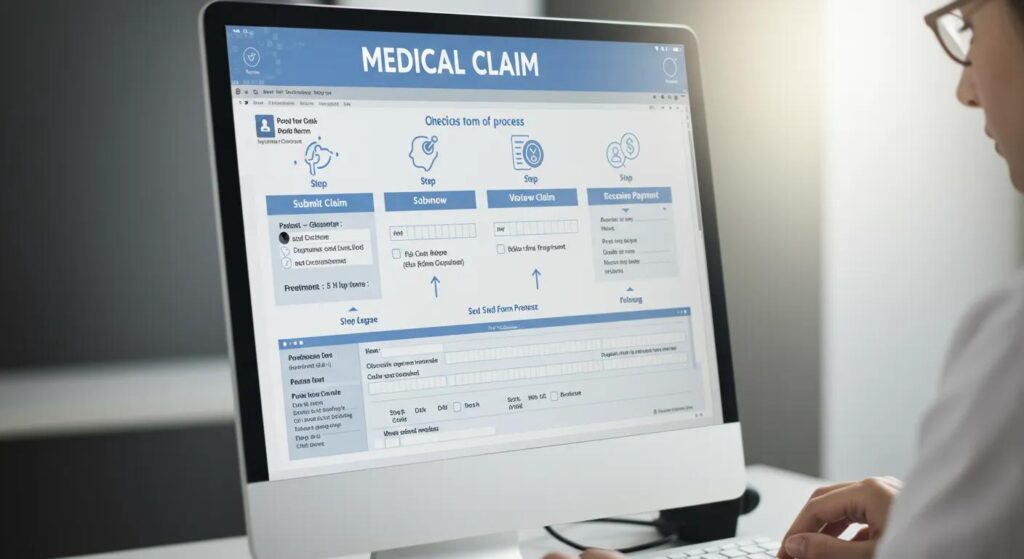- 11/17/2025
- Posted by: Medical Billing Course
- Categories: Medical Billing Certification, Medical Billing Course, Medical Billing Employment

Mastering the Insurance Claim Process for Medical Billing: Your Comprehensive Guide to Understanding and Managing Medical Claims
Grasping the insurance claim process is fundamental to any thriving medical billing operation, ensuring you get paid accurately and keep your revenue cycle humming. In this guide, you’ll learn how medical claims are defined, submitted, tracked, and resolved, transforming complex workflows into smooth, error-resistant procedures. We’ll cover essential elements like CPT and ICD-10 codes, the roles of EOBs and ERAs, strategies for preventing denials, HIPAA compliance, advanced topics such as workers’ compensation and value-based care, and practical steps to launch your own home-based claims business. Whether you’re gearing up for certification or looking to expand your billing services, this article maps out every critical phase of claims mastery and provides direct links to the training resources you need.
“The insurance claim process is the heartbeat of medical billing. Understanding its rhythm, from initial submission to final resolution, is what separates a good biller from an indispensable one, directly influencing a practice’s financial vitality.”- Tri Smith, Instructor, MedicalBillingCourse.com.
Visit our Medical Billing Course – Home to kickstart your journey toward certification and a rewarding career.
Understanding Medical Billing Processes
Medical billing is an intricate dance of steps, from patient registration and charge capture to claim submission and payment posting. Precision in coding, strict adherence to payer guidelines, and effective denial management are vital for a healthy revenue cycle in healthcare. These processes directly influence the financial well-being of healthcare providers.
– American Medical Association, CPT® 2024 Professional Edition (2024)
This citation underscores the critical importance of understanding the medical insurance claim process.
What Is the Medical Insurance Claim Process and Why Is It Important?
The medical insurance claim process is a systematic sequence for submitting, tracking, and reconciling healthcare service charges with payers to ensure prompt payment and maintain revenue integrity. Effective claim management boosts cash flow, slashes denials, and enhances patient satisfaction by minimizing billing errors. For aspiring billers, mastering these steps prevents revenue leakage and builds trust with providers and insurers, a core skill introduced in our What is Medical Billing? overview.
What Defines a Medical Insurance Claim?
A medical insurance claim is essentially a formal request from a healthcare provider to an insurer, seeking payment for services rendered under a patient’s policy. It includes patient demographics, service specifics, diagnostic codes, and charge amounts, all presented in standardized formats. This definition clarifies how clinical encounters are translated into financial transactions, a concept further developed in our Course Program – Part 1 training at Medical Billing Course Program – Part 1, where foundational claim principles are thoroughly taught.
How Does the Insurance Claim Process Impact Medical Billing?
The insurance claim process dictates the speed and accuracy with which providers receive reimbursement, directly impacting accounts receivable and cash-flow stability. Streamlined workflows reduce manual corrections and denial rates, allowing medical billers to concentrate on optimizing the revenue cycle. By connecting service documentation with payer requirements, this process forms the basis of every billing task and shapes the best practices we cover in our advanced modules.
What Are the Key Entities Involved in Medical Claims?
Claims depend on several standardized entities, each crucial for precise adjudication:
Before we delve deeper, let’s compare these core components:
These entities provide the framework for claim creation, submission, adjudication, and payment, leading us to outline the essential submission steps in the following section.
What Are the Essential Steps in the Medical Insurance Claim Submission Process?

A well-structured claim submission workflow minimizes errors and the risk of denials by ensuring alignment between clinical documentation, coding accuracy, and payer requirements. This organized approach streamlines revenue cycle management and is a cornerstone of our Medical Billing Course Program – Part 2, which explores advanced claim procedures and includes our Home-based Medical Billing Business modules.
How Is Patient Information Collected and Verified?
Patient registration and eligibility verification are key to capturing demographics, insurance coverage, and policy details right at the point of care. Confirming benefits and any preauthorization needs upfront prevents claim rejections and safeguards provider revenue. This vital front-end check establishes the foundation for accurate charge capture and coding.
What Is Charge Capture and How Is It Entered?
Charge capture is the process of translating clinical services into billable line items, ensuring no revenue is missed. Billers meticulously document services rendered, assign the corresponding CPT or HCPCS codes, and input these charges into the billing system. Mastering this mechanism prevents underbilling and ensures claim accuracy throughout the billing cycle.
How Does Accurate Medical Coding Affect Claims?
Accurate medical coding is directly linked to claim acceptance, as it matches services to payer guidelines and demonstrates medical necessity. The correct application of CPT and ICD-10 codes prevents coding mismatches, speeds up payment, and helps avoid regulatory penalties, a skill set honed in our Medical Billing and Coding Explained module.
How Are Claim Forms Prepared and Submitted?
Claims are compiled into standardized formats, CMS-1500 for professional services and UB-04 for facility charges, and then transmitted electronically through clearinghouses. This ensures consistent data exchange and faster processing. Electronic form validation flags any missing or mismatched fields before submission, cutting down on resubmission delays.
What Role Do Clearinghouses Play in Claim Submission?
Clearinghouses act as crucial intermediaries, performing scrub checks, converting formats, and batch transmitting claims to payers. They ensure compliance with HIPAA and ANSI X12 standards, alert billers to errors, and provide acceptance acknowledgments, essential services that accelerate the revenue cycle and simplify claim adjudication.
How Is the Medical Claim Lifecycle Managed After Submission?
Post-submission claim lifecycle management involves orchestrating tracking, interpreting explanations, and posting payments to maintain optimal accounts receivable turnover. Efficient workflows in this phase are vital for financial stability and are explored alongside payment posting in our reimbursement modules.
How Can Medical Billers Track and Follow Up on Claims?
Billers monitor claim status using payer portals, clearinghouse dashboards, and ERA notifications. System-generated alerts pinpoint pending, denied, or underpaid claims, prompting targeted follow-up calls or electronic inquiries. This proactive approach prevents revenue gaps and ensures timely resolution.
What Is an Explanation of Benefits (EOB) and How Is It Interpreted?
An Explanation of Benefits (EOB) is a document issued by the payer that details how reimbursement was calculated, including covered services, patient responsibility, and any adjustments.
Accurate interpretation of EOBs ensures that remittance funds are allocated correctly and identifies any discrepancies that require an appeal.
How Does Electronic Remittance Advice (ERA) Support Payment Posting?
ERAs automate the transfer of remittance data, directly mapping payments and adjustments into billing systems. This significantly reduces manual entry errors, speeds up cash posting, and provides essential audit trails for reconciliation.
What Are the Best Practices for Payment Posting and Accounts Receivable?
Efficient payment posting relies on daily reconciliation of ERAs with EOBs, prompt invoicing to patients for outstanding balances, and regular reviews of aging reports. Diligent follow-up on delayed payments and systematic use of AR aging buckets and denial dashboards effectively close revenue loops.
What Are the Common Reasons for Medical Claim Denials and How Can They Be Prevented?

What Are the Top Causes of Claim Denials?
- Missing or invalid patient demographic information
- Incorrect or unspecified medical codes
- Failure to obtain prior authorization for services
- Duplicate claim submissions
- Services not covered under the policy terms
These common root causes highlight areas where process controls need strengthening to reduce denials and improve appeal efficiency.
How Can Medical Billers Prevent Claim Denials?
Preventing denials requires meticulous data entry, automated eligibility checks, precise coding audits, and strict adherence to payer rules. The success stories of our graduates, featured in Medical Billing Success Stories, demonstrate how implementing these strategies can slash denial rates by over 50%.
What Are Effective Steps in the Claim Appeal Process?
An appeal starts with a thorough analysis of denial reason codes, gathering all necessary supporting documentation, and submitting a formal appeal letter within the payer’s specified timelines. Consistent follow-up and escalation protocols are key to recovering valid revenue and maintaining strong payer relationships.
How Do Payer-Specific Guidelines Affect Denial Management?
Each payer has unique policies that dictate documentation requirements, appeal timeframes, and submission formats. Tailoring denial worklists and appeal templates to the specific nuances of each insurer maximizes the chances of a successful reversal.
How to Handle Medicare and Medicaid Claim Denials?
Medicare and Medicaid demand strict adherence to national and state regulations, including Local Coverage Determinations (LCDs) and specific appeal levels, guidelines that are thoroughly explained in our HIPAA compliance module.
What Are Strategies for Commercial Insurance Denials?
Commercial plans exhibit significant variation; therefore, maintaining payer-specific claim scrubbing rules, utilizing real-time editing software, and providing targeted coder training are essential for streamlining corrections and preventing repeat denials.
How Does Compliance and Regulation Influence the Insurance Claim Process?
What Is HIPAA and How Does It Affect Claims Processing?
HIPAA establishes patient privacy and security standards for electronic health information, mandating encrypted transmissions, access controls, and audit logs for all claim exchanges. You can learn these essential protocols in our Medical Billing Course Program – HIPAA Compliance.
HIPAA Compliance in Healthcare
HIPAA regulations are paramount for safeguarding patient privacy and ensuring the security of electronic health information. Compliance involves implementing robust measures such as encrypted transmissions, strict access controls, and comprehensive audit logs during claim exchanges. These measures are critical for maintaining patient trust and avoiding legal repercussions.
– U.S. Department of Health & Human Services, HIPAA for Professionals (2024)
This citation reinforces the article’s discussion on HIPAA’s impact on claims processing and the critical need for compliance.
How Are Fraud, Waste, and Abuse Prevented in Medical Billing?
Preventive strategies include conducting regular coding audits, implementing exception reporting for unusual billing patterns, and providing staff training on ethical documentation practices. Establishing strong internal controls and compliance hotlines effectively mitigates risks and upholds organizational integrity.
What Are the Key Payer Policies and Guidelines to Follow?
Every payer provides policy manuals that detail coverage criteria, bundling rules, and modifier usage. Maintaining an up-to-date policy database and integrating payer edits into your billing software ensures that claims consistently meet the latest guidelines.
What Are Advanced Medical Insurance Claim Scenarios and Their Challenges?
How Are Workers’ Compensation Claims Processed Differently?
Workers’ compensation claims involve state-specific litigation codes, lien requirements, and mandatory fee schedules. Billers must navigate case investigators, employer reporting obligations, and denial follow-ups that are distinct from standard claims processing.
What Is Personal Injury Protection (PIP) and How Is It Billed?
PIP covers no-fault motor vehicle injuries and comes with its own set of claim forms, timelines, and maximum benefit caps. Thorough documentation of accident details, treatment plans, and coordination with auto insurers is essential for achieving full reimbursement.
How Does Coordination of Benefits (COB) Work in Claims?
COB determines which payer is primary and which is secondary when multiple coverages are in play. Billers must sequence claims correctly, gather “other insurance” details, and bill secondary payers after receiving primary remittance to maximize the total payment received.
What Are Bundled Payments and Value-Based Care Billing?
Value-based models link reimbursement to quality metrics and episode-of-care costs. Billers need to implement bundled payment codes and track performance indicators, integrating clinical data with financial claims to support outcomes-based revenue.
How Can You Build a Successful Medical Billing Business Focused on Insurance Claims?
What Are the Steps to Set Up a Home-Based Claims Business?
- Establish Legal Entity: Register an LLC or sole proprietorship to manage liability effectively.
- Obtain NPI and Tax IDs: Secure your National Provider Identifier and employer identification numbers.
- Invest in Billing Software: Select platforms equipped with claim scrubbing, EDI, and AR management modules.
- Develop Compliance Protocols: Implement robust HIPAA policies and essential security measures.
How Do You Acquire Clients for Medical Billing Claims Services?
Effective marketing strategies include networking with local practices, targeted digital advertising, and offering complimentary claim audits. Building referral partnerships with healthcare consultants and leveraging positive Graduate Reviews significantly boosts credibility.
What Are the Best Medical Billing Software Options for Claims?
Leading solutions offer features such as automated eligibility checks, electronic claim submission capabilities, denial analytics, and comprehensive reporting dashboards. Prioritize cloud-based platforms with regular updates and scalable pricing models that align with your business growth.
How Does Certification Enhance Your Claims Processing Career?
Obtaining a recognized credential validates your expertise in claim workflows, compliance, and denial management, thereby enhancing client trust and career advancement opportunities. Explore program timelines and durations in “How Long Does Medical Billing Take?” at Medical Billing – How Long?.
Launching a business armed with certified skills positions you for sustained success in the dynamic healthcare landscape.
“I started my own medical billing business after taking this course. It gave me the confidence and knowledge I needed to succeed. My business is thriving, and I love the flexibility it offers.”
– Jessica L., MedicalBillingCourse.com Graduate
Embarking on a career in medical billing requires both comprehensive knowledge and practical, hands-on experience. By mastering each phase of the insurance claim process, from patient registration through advanced scenarios and compliance protocols, you’ll drive efficient revenue cycles and build a thriving billing enterprise. Explore our certification courses to gain the practical training, expert instruction, and industry-proven strategies that empower you to excel as a medical biller or business owner.
About the Author
Tri Smith is a dedicated Instructor at MedicalBillingCourse.com, where he passionately helps students transform their futures through comprehensive medical billing certification. With over five years of experience as an instructor, Tri takes immense pride in seeing his graduates succeed, whether they go on to land remote jobs, grow within healthcare offices, or launch their own thriving billing businesses. His greatest joy comes from empowering students to build meaningful, flexible careers in the dynamic healthcare field.

